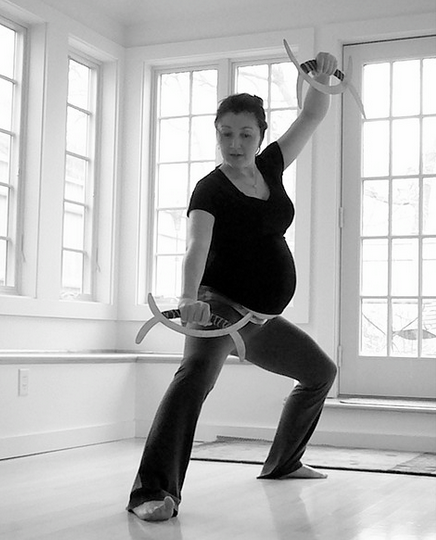With everyone realizing the benefits of yoga, and doctors recommending yoga during pregnancy, a lot of people recently have been asking me, “what is the difference between prenatal yoga and a typical yoga class?” and “if I’m pregnant, is it still okay to practice in a typical yoga class?”
Let me just start by saying hot yoga is a big no-no during pregnancy because we don’t want to raise the internal body temperature. Think about it, really, would we get in a hot tub, sauna, or tanning bed when pregnant? No. Same applies here.
In a typical yoga class, we move through standing postures, balancing, twists, forward and backward bends, poses on the belly and poses on the back.
During pregnancy, we shouldn’t twist, do back-bends, lay on the belly or back. Even forward bends have to be taken with care.
Allow me to explain why.
We never want to be adding a lot of pressure to the baby’s home, even in the first trimester, because it can lead to miscarriages. Back poses should be avoided because they put pressure on the vena cava, which can limit the blood supply to the baby.
Even savasana should be done either on the left side, or propped up with bolsters. Twists and backward bends are also not advisable because of the belly. We have probably all see a beautiful picture of a pregnant woman in a full back-bend, gorgeous belly popping out. While it looks amazing, this poor woman will likely experience diastasis recti.
Diastasis recti is when the abdominal muscles split, which causes that post-baby belly or ‘pooch.’ When pregnant, the abdominal muscles are already under more pressure and stretching, because the body is busy building a tiny human.
Twists and backward bends can tear these muscles, although it is something that can be repaired with a lot of work. Sit-ups and exercises that directly work these same muscles are the last thing that will help repair them. Side core exercises and exercises that work the more subtle layers of the core are the best way to repair these muscles.
This brings me to the next topic. It has been said that during pregnancy, we should continue doing whatever it was that we were doing before pregnancy, but with modifications.
If we were regular with our yoga, running, weight lifting, etc, yes, we can continue, but not at the full 95 to 100 percent intensity we once did. And when I say regular with it, I mean about four to five times per week over a few years, not once a week for a couple months. During pregnancy, it is best to go to about 85 to 90 percent of your capabilities.
When pregnant, the body produces the hormone ‘relaxin,’ which, as it sounds, relaxes the body. This is to help with the process of labor.
Relaxin is highest at three different times during gestation: at about 14 weeks; at birth; and for about six to nine months post-pregnancy. That’s quite a long time! The body is much more flexible during this time and it is more important to take care. If the ligaments get overstretched, it can be very painful, and they can even tear and be permanently damaged.
In a typical yoga class, even some breathing exercises, such as Bhastrika, Kapalabhati, and Kumbuka can not be performed while pregnant.
There are some poses which are fine during one part of pregnancy, but not during another. Also, if experiencing typical conditions of pregnancy, such as hemorrhoids, high blood pressure, a breech baby, nausea, etc., there are some poses that should be avoided.
A yoga teacher who has not trained in prenatal yoga can not possibly know all the things to avoid and modifications to perform instead, nor do they have time if leading a fast class, such as vinyasa.
So, if we also don’t know these things, it is best to go to a prenatal yoga class with an instructor who has done training specific to prenatal, not just a 200 hour instructor, who only learns a small piece of prenatal, as a “just-in-case.”
The wonderful thing about a prenatal yoga class is that is created for pregnancy and already takes all the things above into account! We don’t have to worry about a thing! Just tell the instructor at the beginning of class if there have been any changes in the pregnancy and our bodies, and he or she will make sure to modify for you.
Prenatal yoga is generally slower, offering us time to talk to other pregnant women and ask questions. It is focused on connecting mama with baby and keeping both mama and baby safe, and geared towards opening the hips, strengthening the pelvic floor muscles, and meditating through a ‘Keep-Up’ exercise.
A “Keep-Up” is a pose, generally done with the arms, that is held for a period of five to eight minutes. The purpose is to find comfort in the discomfort. We do this so we aren’t completely blindsided by labor.
In prenatal yoga, we will prepare ourselves for what is to come in pregnancy and labor, relax, de-stress, and connect with other pregnant women, ourselves and our baby.
It is such a beautiful time and deserving of so much care and love!
Love elephant and want to go steady?
Sign up for our (curated) daily and weekly newsletters!
Editorial Assistant: Bronwyn Petry/Editor: Catherine Monkman
Photo: Bonbon, Flickr Creative Commons







Read 0 comments and reply